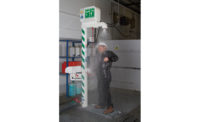 Emergency safety showers provide the first line of defence in the event of a chemical spillage. When workers come into contact with dangerous substances they need to be able to wash it off quickly. Delays exacerbate the situation resulting in more serious injury with possible long-term consequences, permanent disability, and even death.
Emergency safety showers provide the first line of defence in the event of a chemical spillage. When workers come into contact with dangerous substances they need to be able to wash it off quickly. Delays exacerbate the situation resulting in more serious injury with possible long-term consequences, permanent disability, and even death.
Factors such as the procedures, chemicals, and the role of the worker influence the selection of emergency safety showers. Understanding them will help you ensure the most effective treatment is available for your workforce.
Emergency safety showers should be sited as close to the workplace as possible, accessible at all times, and easy to operate. In practice however, there are important issues to resolve long before arriving at the point of installation.
Importance of standards
Compliance with recognised standards may be mandatory on some sites. The American National ANSI Z 358.1 2014 standard is recognised around the world and is considered the most comprehensive. It provides guidance for determining the flow rate, duration of operation, and water temperatures necessary for safe, effective use of emergency safety showers. It provides a benchmark for designers and a reference for those who have to specify equipment, regardless of where it is to be used.
Choices
The obvious questions is: What type of shower?
Showers can be floor standing, mounted on walls, or in the ceiling, and are generally plumbed in.
Where the mains supply is unreliable or non-existent, tank showers offer an effective alternative. They are equipped to provide tepid water between 16°C and 38°C to ANSI standard regardless of environment.
Safe water temperature is essential if emergency safety showers are to be used properly. If the water is too hot or cold it could cause shock and even add to serious injury, preventing casualties from remaining under the shower long enough for decontamination.
Handling the heat
In hot climates, such as desert regions where ambient temperatures can hit 50 degrees, the temperature of the water in a tank can rise and water cooling is required.
One of the most effective methods is a chiller unit attached to the side of the tank. Water circulates through the chiller and when the temperature raises the unit switches on to keep the water at compliant temperature at all times
As an alternative to this, centralised ring main chiller systems are available. These are effective for sites with large numbers of showers, particularly in hazardous areas. The cost of a centralised unit can be less than the cost of providing individual chillers to a flameproof specification.
Out in the cold
Showers are also expected to operate in sub-zero conditions. Preventing the water from freezing is essential, but protecting casualties in even the harshest conditions is essential.
One solution has been to create a ‘winterised booth’ shower. Mains water is mixed with water from a thermostatically controlled cylinder to give the correct temperature at the shower head. The shower is enclosed with insulated doors and a space heater keep casualties warm until help arrives.
The USA has a wide range of emergency shower providers, with some including Hughes Safety Showers in Houston, TX concentrating on professional solutions for Oil, Gas, Chemical and Petrochemical environments across the country and throughout the world.
Author: Dan Gray – Hughes Safety Showers. www.hughes-safety-showers.com


